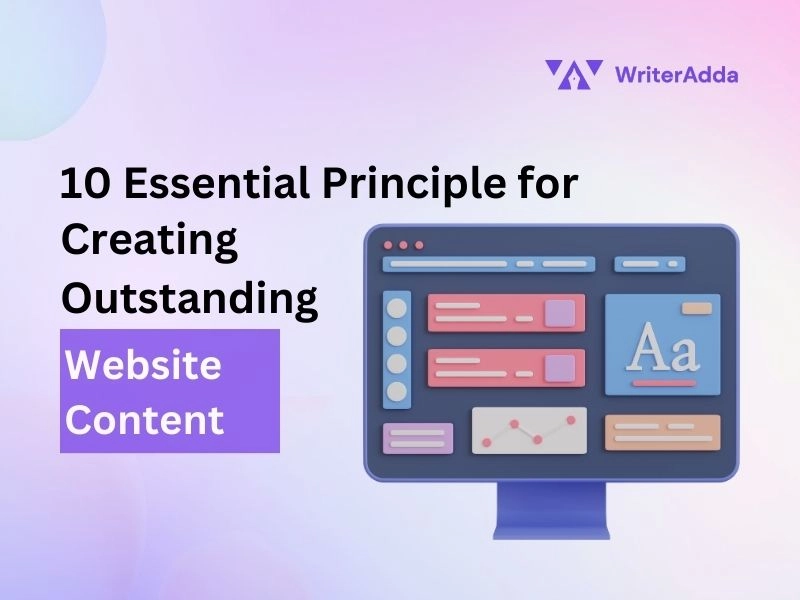It may be quite difficult to engage readers with captivating website material. The majority of website visitors won’t stay on a page for more than a few seconds before moving on. The secret to overcome these odds is effective website authoring. Web-optimized content that is well-written gets to the top of search results and keeps readers interested.
Your content should be your top concern when building a website. However, you don’t have to take our word for it; you can check the evidence. If a website’s content or appearance are ugly, more than one-third of visitors will cease interacting with it.
Both readers and SEO are taken into consideration while writing engaging online content. And you’ll need to make an effort if you want to get the recognition you properly deserve. But don’t worry—you’re not fighting this battle by yourself. The following advice on creating website content can assist you in increasing website traffic and conversion rates.
1. Recognize Your Demographic
It may seem simple, yet many experienced writers begin their work before fully grasping who their target audience is and the type of content that is required for them. Remember to ask yourself these questions before you start writing a piece of content. Whom am I trying to reach? How can you differentiate between their primary and secondary audiences? How can I provide quality content for my particular audience? These straightforward inquiries can help you create interesting pieces of content. Take the example of writing an article for a law firm. Potential consumers and current clients might be your main target audience. However, your secondary audience is far larger and may include legal journalists, attorneys, or any other person or company who could subsequently want your services. Your first step toward being a top content writer will be to understand your audience.
2. Offer Value
Apart from writing well and using attractive language, you must be able to add meaning to the words you use and the content you generate. Now that you are aware of who your audience is, you should speak to them personally and in a manner consistent with their interests. For every line you write, ask yourself, “Would my targeted viewers care about this sentence?” Reorganize your language to speak to their needs, solve their issues, and pique their interest. You should also take into account the prevalent online patterns for content from important and well-liked publications. Use the content in these publications as motivation for your own work, including the wording on your homepage and blog articles. Find a way to outperform them. As a result, you’ll develop natural sales skills.
3. Inverse Pyramidal Structure
We are all aware that readers today have a short attention span, and they will decide quickly whether or not your webpage has the information they are seeking for. Consequently, it is crucial to structure your material like an inverted pyramid. The important points should be made clear right away. The opening paragraph ought to be compelling and able to grab readers’ curiosity. Once you have the reader’s interest, keep them interested with a wealth of information and figures.
4. Always Include Citations in Your Content
Whenever you utilize content from another website, be sure to add a link back to it. You would desire the same politeness since it is excellent online etiquette. Always mention your references, even if you’re worried that it will drive people away from your website. If you’re really worried, you may always use the “open link in another window” option.
5. Avoid Overselling Your Goods or Services
A thoughtful mix of promotional and non-promotional information is required for high-quality content authoring. Yes, the website’s goal is to advertise your services, but it doesn’t imply you should inundate viewers with requests to subscribe or buy anything. Before you ask them whether they’re interested in becoming a customer, provide them with useful, interesting material that they can appreciate.
6. Simple And Concise Language
Understanding how to organize and write your material is the next stage. Write concise, uncomplicated phrases. More people will read content that is simple to understand. Take care to pay attention to language; no mistakes are acceptable here. To assess your readability score, there are several free internet readability tools accessible.
7. Include Multimedia Elements
It’s important to realize that an article is more than just words and sentences when producing excellent content. Your article is made alive by a variety of additional factors. Real-world examples that might assist a reader with regard to your article’s main issue are the first thing you should provide. You may also utilize visuals, statistics, tables, charts, and infographics in addition to these. A reader can better comprehend a subject or an idea with the aid of images and diagrams. As a result, they also aid in making your post stand out from the competition and improve the SEO of your website. As a result, 88 percent of marketers prefer visual content since 64 percent of consumers are more inclined to make a purchase after seeing a video or visual representation of your product or service.
8. Steer Clear Of Jargon
Jargon is the inside jokes you and the other participants in your industry have with one another. Though irrelevant to the majority of page visitors, it is specific to you. Assume that visitors to your website have never heard of your company or anything even somewhat associated with it. Speak to them in straightforward, understandable language. The number of people who might read your material will grow as a result. In light of this, creating evergreen content on subjects with steady interest and search traffic over time is a wonderful strategy to make sure your content is suitable and pertinent for years to come.
9. Update Your Links
The majority of website content creators are aware of the value of internal links. Linking to other pages on your website improves SEO, provides users with helpful information, and extends their time on your site. However, it’s insufficient. To add new links to earlier articles and pages, you must revisit them. This improves user experience, increases the usefulness and relevance of your pages to users, and keeps your material current. It’s only a small portion of updating outdated, evergreen material to boost SEO.
10. Always Proofread
Posting shoddy material to your company website is one method to ensure that nobody notices it among the 1.9 billion websites now available online. Take your time proofreading your work since errors in spelling or grammar are the biggest detriment to your reputation. Our brains instinctively complete circuits, thus it’s totally feasible for you to see as clean information what someone else reads and may readily identify as having multiple necessary adjustments. To calm your mind, try reading your writing aloud. Once you’re convinced that the content is error-free, have someone else read it.
Conclusion
Writing is difficult in general, and creating material for a website is significantly harder. But keep in mind that you don’t have to create flawless sentences the first time! Once your content is published, you may execute recurring website audits to track and improve its functionality. With the aforementioned advice, you’re ready to produce compelling material that appeals to even the ficklest and busiest online users.




